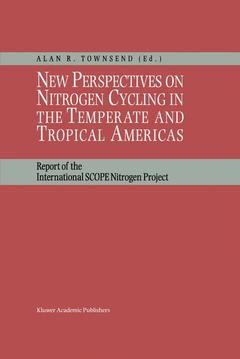Description
New Perspectives on Nitrogen Cycling in the Temperate and Tropical Americas, 1999
Report of the International SCOPE Nitrogen Project
Coordinator: Townsend Alan R.
Language: English
Subjects for New Perspectives on Nitrogen Cycling in the Temperate...:
Keywords
bacteria; combustion; ecosystem; ecosystems; environment; plankton; soil
Publication date: 10-2012
293 p. · 15.5x23.5 cm · Paperback
293 p. · 15.5x23.5 cm · Paperback
Description
/li>Contents
/li>
Inputs of nitrogen to terrestrial and aquatic ecosystems have increased several-fold over the last one hundred and fifty years, with the steepest increases during the last four decades. The expansion of fertilizer manu facture and use, the increase in fossil fuel combustion, the intensification of animal husbandry, and widespread cultivation of N2 fixing crops have all contributed to the dramatic increase in N inputs. The increase has been most rapid in Northern Hemisphere (NH) temperate ecosystems, but presently subtropical and tropical regions of Asia are also experiencing an explosive increase in N inputs to terrestrial ecosystems (W. Chameides, pers. comm. ; Galloway et al. 1996). Projected increases in N deposition for these trop ical and subtropical regions, with a high natural background of N inputs, exceed increases projected for temperate and arctic regions (Cleveland et al. submitted; Galloway et al. 1994; Holland & Lamarque 1997a). Compared to biological N fixation, N deposition is becoming a proportionately greater source of N to terrestrial and aquatic ecosystems worldwide (Vitousek et al. 1997). 6 The nitrogen contained in the atmosphere as N , 3. 9 * 10 Tg (Tg = 2 12 10 g), is the largest reservoir of N in the Earth system (Warneck 1988). However, this paper focuses on the nitrogen emissions and deposition that have been transformed from N2 into reactive forms that are biologically avail able (e. g. Vitousek et al. 1997).
Foreword; A.R. Townsend. An etymology of nitrogen; J.E. Corredor. Contemporary and pre-industrial global reactive nitrogen budgets; E.A. Holland, et al. Nitrogen stable isotopic composition of leaves and soil: tropical vs. temperate forests; L.A. Martinelli, et al. The globalization of N deposition: ecosystem consequences in tropical environments; P.A. Matson, et al. A nitrogen budget for late-successional hillslope Tabonuco Forest, Puerto Rico; T.J. Chestnut, et al. The impact of accelerating land-use change on the N-cycle of tropical aquatic ecosystems: current conditions and projected changes; J.A. Downing, et al. Nitrogen yields from undisturbed watersheds in the Americas; W.M. Lewis, et al. Nitrogen cycling and anthropogenic impact in the tropical interamerican seas; J.E. Corredor, et al. Ecosystem constraints to symbiotic nitrogen fixers: a simple model and its implications; P.M. Vitousek, C.B. Field. Do top-down and bottom-up controls interact to exclude nitrogen-fixing cyanobacteria from the plankton of estuaries? An exploration with a simulation model; R.W. Howarth, et al. The presence of nitrogen fixing legumes in terrestrial communities: evolutionary vs. ecological considerations; T.E. Crews. Nitrogen limitation in dryland ecosystems: responses to geographical and temporal variation in precipitation; D.U. Hooper, L. Johnson.
© 2024 LAVOISIER S.A.S.




